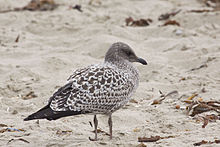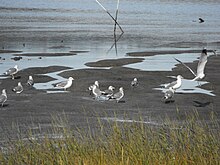Californian gull
| Californian gull | ||||||||||||
|---|---|---|---|---|---|---|---|---|---|---|---|---|

Californian gull ( Larus californicus ) |
||||||||||||
| Systematics | ||||||||||||
|
||||||||||||
| Scientific name | ||||||||||||
| Larus californicus | ||||||||||||
| Lawrence , 1854 |
The California Gull ( Larus californicus ) is a bird art within the gulls (Larinae). It breeds on islands in salt and inland lakes in western North America and is found in winter on the west coast between British Columbia and Mexico .
description
With a body length of 45–51 cm and a wingspan of 122–140 cm, the Californian gull is somewhere between the ring-billed gull and the herring gull . Compared to the very similar ring-billed gull, it has a longer and slimmer beak, a smaller head, a relatively rounded "bow" with a bulging chest and a clearly rounded belly and a relatively slender abdomen.
Adult birds
In breeding plumage the head, neck and bottom are white. The yellow beak has a red gony spot , a subterminal , black band and a light tip. It has a four-color effect and is a distinctive feature of the North American west coast. The iris is dark and enclosed by a red orbital ring . The shoulder and back feathers are dark blue-gray. Two crescent-shaped hems on the rear shoulder feathers and on the umbrella feathers clearly stand out from this in the seated bird . The rear edge of the arm wing is noticeably broadly lined with white. The tip of the hand wing is black and stands out as a relatively clearly defined triangle from the rest of the wing. The two outer hand wings show a subterminal white field and like the other hand wings white tips. The tail is completely white. The leg color varies between gray and yellow.
In the winter dress, the back of the head in particular is darkly dashed; the drawing is often concentrated in the form of a dark neck band that can reach down to the sides of the chest.
Youth dress
The youth dress is similar to that of the American herring gull and is predominantly dark brown with a lighter forehead, a lightened lower abdomen and beige-brown under tail-coverts, which stand out with their coarse, dark banding. In very young birds, the color plays into the cinnamon brown, but this soon diminishes as the plumage is worn down. Back and shoulder feathers appear scaled due to dark feather centers and light hems, but not as clearly as in American herring gulls. On the dark top of the wing there are two light bands that are formed by the light tips of the medium and large arm covers. In contrast to the American herring gull, there is no light field on the inner wings of the hand. The rump is roughly banded on a light background, the tail is dark, as is the lower wing. The bill and eyes are dark, the legs flesh-colored.
Immature birds
In the first winter, the beak has clearly lightened flesh-colored except for a black tip. In general, the bird is lighter brown than when young, especially the face. The back and shoulder feathers are extremely variable, but mostly gray with dark subterminal bands or spots. The large arm covers stand out optically from the wing with their dark feather centers.
In the second winter, the head, neck and underside of the bird is largely white with a gray base of the beak and dark dotted lines that condense in the neck and sometimes even reach the flanks. The back, shoulders and middle arm covers are largely gray and stand out from the other wing covers, which are drawn in brown. The rump is white and the tail shows a wide black band. The leg color varies between gray, yellow and flesh-colored. Birds in the second winter are similar to the American herring gulls in the third winter, but the latter differ in their more powerful beak and the already light iris.
Birds in the third winter are already very similar to adult birds, but still differ in the gray base of their beak, the remains of brown markings on the armpits, the very narrow white tip hems of the hand wings and the remains of a dark tail band. The color of the legs is still variable as in the second winter.
voice
The vocal utterances (audio sample) are comparable to those of the American herring gull, but rougher and more squeaky. A short and deep goool is reminiscent of the calls of the black-headed gull . The long call is fast, high and gasping.
Distribution and existence
The breeding distribution of the California gull extends from the southern catchment area of the Mackenzie River and the Great Slave Lake south over Alberta and western Manitoba south to the United States, where the species range extends from eastern Washington over the Great Basin east to South Dakota . In the south, the distribution extends to eastern California and Colorado .
The population is estimated to be around 200,000 pairs or 620,000 adult birds and is divided into over 100 colonies. By the 1930s, the population had fallen to around 50,000 breeding pairs. The main reason was the commercial collection of eggs in the late 19th century. After the species was placed under protection at the beginning of the 20th century, the population increased again and amounted to around 140,000 breeding pairs in the 1980s. During this time, the species was able to expand its range significantly. The largest colonies are located at the Great Salt Lake and Mono Lake . The Canadian population comprises at least 20,000 breeding pairs. The IUCN does not consider the Californian gull to be threatened (“least concern”).
Geographic variation
Two subspecies are recognized, of which the northeastern L. c. albertaensis is somewhat larger and more powerfully built, has a more powerful bill and shorter legs. In addition, the upper side is a little lighter, the wing tip shows less black and the dotted lines of the head in winter dress are more extensive than in the nominate form . The two subspecies used to occur in disjoint sub-areas. As a result of recent expansion, a contact zone has again emerged east of the Rocky Mountains.
- L. c. californicus Lawrence , 1854 - south from Washington and Montana to California, Wyoming and Colorado, possibly British Columbia
- L. c. albertaensis Jehl , 1987 - northern Great Plains (south to Montana and North Dakota ) as well as southern and central Canada

hikes
After the breeding season, many younger animals in particular first move north to the northwestern Pacific in southeastern Alaska , before moving to the main wintering areas on the California and Mexican Pacific coasts. The subspecies L. a. albertaensis makes a skipping move and winters overall southwards and to a large extent inland. The species as a whole winters south to Baja California and Colima and as far as the north of the state of México .
In the Midwest , Colorado, and the central southern states , the species is an occasional winter visitor. It appears rarely, but regularly, in the Yukon , Québec and Texas . She was reported as a random visitor from Virginia , Delaware and Florida , Hawaii and Japan .
habitat
Outside the breeding season, the California gull can be found on coasts, estuaries and bays, on muddy surfaces, in swamps and marshes and on agricultural areas. The breeding colonies are in arid areas inland, usually flat, rocky islands in freshwater or salt lakes.
food
The diet of the California gull consists of insects and their larvae, bird eggs and cubs up to the size of Canada goose chicks , earthworms , crabs, small rodents , carrion and waste, fruits and grains. The most common animal prey include locusts and crickets , which is why the species is considered useful. The food spectrum can vary locally; in British Columbia, for example, grain, waste or insects were the main foodstuffs in different colonies. Since the species sometimes specializes in bird eggs and nestlings locally, it can destroy the breeding success of the duck population in some lakes. Elsewhere, she specializes in gradations on rodents or causes damage in orchards. It also feeds on bird carcasses during botulism epidemics.
Reproduction
The Californian gull returns to the breeding colonies between March and May, the breeding season usually begins in June, more rarely in mid-May. The partners of a couple are mostly of the same age, which suggests a long-term monogamy . The breeding density in the colonies is often very high and can be up to 77 breeding pairs per 100 m². Territorial conflicts then increase the mortality of adult birds. Breeding success is highest in the middle of colonies and in the protection of shrubbery.
The clutch usually consists of three eggs, but two eggs are the rule in the large tank. The incubation period is between 26 and 28 days and the nestling period is around 40 days.
Individual evidence
- ↑ Olsen / Larsson (2003), p. 116, see literature
- ↑ Andrew Spencer: XC14086 Californian gull Larus californicus (MP3) xeno-canto.org. August 7, 2007. Accessed June 1, 2019.
- ↑ Olsen / Larsson (2003), p. 117, see literature
- ↑ a b c d Olsen / Larsson (2003), p. 123f, s. literature
- ↑ a b BirdLife Species Factsheet, s. Web links
- ^ DA Sibley: The Sibley Field Guide to Birds of Eastern North America , AA Knopf, New York 2003, ISBN 0-679-45120-X
- ↑ Jehl (1987), see literature
- ↑ a b c Del Hoyo et al. (1996), see literature
literature
- Klaus Malling Olsen, Hans Larsson: Gulls of Europe, Asia and North America , Helm Identification Guides, Christopher Helm, London 2003 (corrected new edition from 2004), ISBN 978-0-7136-7087-5
- Josep del Hoyo , Andrew Elliott, Jordi Sargatal (eds.): Handbook of the Birds of the World. Volume 3: Hoatzin to Auks. Lynx Edicions 1996, ISBN 978-84-87334-20-7 , pp. 604-605.
- Joseph R. Jehl, Jr .: Geographic Variation and Evolution in the California Gull (Larus californicus) , The Auk 104 (1987), pp. 421–428, ( PDF )
- Gerald S. Tuck, Hermann Heinzel : The sea birds of the world. Paul Parey Publishing House, Hamburg / Berlin 1980, ISBN 3-490-07818-7 .
Web links
- Larus californicus in the endangered Red List species the IUCN 2009. Posted by: BirdLife International, 2008. Accessed July 7 2011th
- BirdLife International: Species Factsheet - California Gull ( Larus californicus ) . Retrieved July 7, 2011.
- Videos, photos and sound recordings of Larus californicus in the Internet Bird Collection
- xeno-canto: Sound recordings - California Gull ( Larus californicus )



